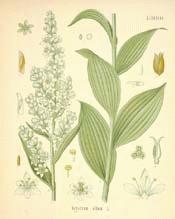
Botanical.com Home Page

|
White False Hellebore
(Veratrum album LINN.)
Click on graphic for larger image
|
Hellebore, White
POISON!
Botanical: Veratrum album
Family: N.O. Lilaceae
---Synonyms---Veratrum Lobelianium. Veratrum Californicum. Weiszer Germer. Weisze Nieszwurzel.
---Parts Used---Rhizome, root.
---Habitat---Europe, from Lapland to Italy. Does not occur in the British Isles.
---Description---Veratrum album closely resembles the American species, but is distinguished by its yellowish-white flower.
The fresh rhizome has an alliaceous odour, but when dried it has no marked smell. Its taste is first sweet, then bitter and acrid, leaving the tongue tingling and numb. Its powder is ash-coloured. White Hellebore deteriorates by keeping. It is scarcely ever used internally owing to the severity of its action. It is stated to have been one of the principal poisons used in Europe for arrows, daggers, etc.
---Constituents---Authorities differ as to the presence or absence of the veratria of cevadilla. It contains jervine, pseudo-jer-vine, rubijervine, veratralbine and veratrine. Cevadine is stated to be absent. There is fatty matter, composed of olein, stearin and a volatile acid, supergallate of Veratia, yellow colouring matter, starch ligneous matter, and gum; the ashes contain much phosphate and carbonate of lime, carbonate of potassa and some traces of silica, and sulphate of lime. There has been found in it a white, crystalline, fusible and inflammable substance called barytin, of which the properties have not been thoroughly investigated.
---Medicinal Action and Uses---A violent, irritant poison. When snuffed up the nose it occasions profuse running of the nose; when swallowed, severe vomiting and profuse diarrhoea. It was formerly used in cerebral affections, such as mania, epilepsy, etc., and for gout, as a substitute for colchicum or the Eau Mediciale of Husson, when 3 parts of the wine of White Hellebore added to 1 part of laudanum was given in doses of from 1/2 fluid drachm to 2 fluid drachms.
It is occasionally used in the form of an ointment or decoction in obstinate skin diseases such as scabies, or to kill lice, but even this use is not free from danger. It is also occasionally used as an errhine or sternutatory, diluted with starch or other mild powder, in cases of amaurosis and chronic affections of the brain.
The principal use of the plant is in veterinary medicine.
---Dosages---Of the powder, 1 to 8 grains, gradually and cautiously increased, commencing with 1 grain. Of the vinous tincture, from 20 to 60 minims.
---Poisons, if any, and Antidotes---Narcotic symptoms, such as stupor and convulsions, appear in addition to vomiting and diarrhcea, when the dose is fatal. The poison may be treated by drinks and injections of coffee, stimulants to overcome the depressed condition of the heart and arteries, and opiates and demulcents to relieve internal inflammation.
---Other Species---
Helleborus orientalis (Lam.). A tincture ofthe root is used in homoeopathy for indigestion and diarrhcea.
See also:
BEARSFOOT (HELLEBORE, STINKING) - BEARSFOOT (BRITISH)
SABADILLA
[Top]
Common Name Index
A MODERN HERBAL Home Page
Bear in mind "A Modern Herbal" was written with the conventional wisdom of the early 1900's. This should be taken into account as some of the information may now be considered inaccurate, or not in accordance with modern medicine.
© Copyright Protected 1995-2025 Botanical.com
|

